Animals found in and around Camelback Canyon Estates
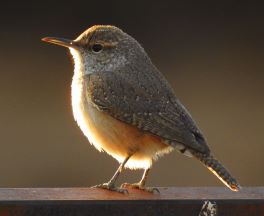
Birds of Camelback Mountain – We see and hear a wide variety of bird life around Camelback Mountain. We have so many, in fact, that we have compiled a checklist and a visual guide to our many avian friends.
Click here to download your own Visual Guide and Checklist.
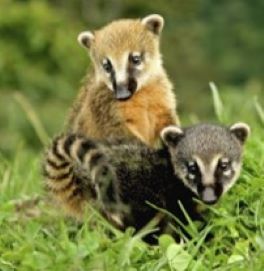
Coati (or Coatimundi) – Our elusive nocturnal Coati friends (sometimes called Mexican raccoons) like to eat fruit, nuts, small mammals and reptiles. They can run up to 15 mph, and weigh 6 to 18 lbs. You may spot them on your security camera rooting around for food. They can be fierce, so they are best left alone.

Desert Cottontail Rabbit – The Cottontail Rabbit gets its name from its stub tail with white undersides, looking like a cottontail as it retreats and scurries across the path. They are plentiful on Camelback Mountain. They generally spend their entire lives on 10 acres or less. They use natural cavities and burrows of other animals for their dens. They eat vegetables, flowers in the summer, and cause damage to lower portion of woody plants in the fall and winter.
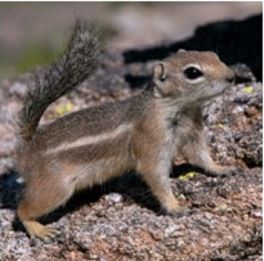
Harris’s Antelope Squirrel – The Antelope Squirrel (or Harris’s Ground Squirrel) is native to Arizona, New Mexico and Sonora, Mexico. It has adapted to the extreme high temperatures by heat dumping from its body. It moves to shaded position and lie spread eagled against the ground. They eat fruit and seeds of local cactus plants as well as beans of the mesquite. They also eat insects, small rodents and carrion. They weigh 4-5 ounces, and measure 8-10 inches minus their tail.

Gray Fox – The gray fox has a silver-gray coat with reddish legs and chest and white on its throat and underbelly. A thin black stripe runs from the outside corner of each eye to the side of the head. He is the only member of the dog family that will climb trees. They are omnivores eating small mammals, eggs, birds, insects, and lizards. He lives in a den in hollowed out logs or in caves. Or they may take over an abandoned burrow. He weight about 4-5 pounds and stands 12-15 inches at the shoulder.
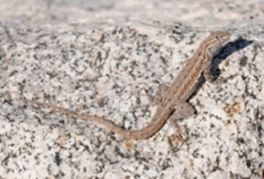
Side Blotched Lizard – Our most common lizard is a Side-blotched Lizard. They are small lizards, up to 5 inches long. They can be distinguished by a dark blue-gray to black blotch just behind each of their front limbs. Their back is light gray or tan and most have both light and dark spots. They live in sandy or rocky areas around desert shrubs. They east insects including scorpions, spiders, termites and ants.
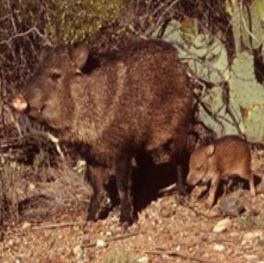
Javelina – Javelinas live in desert washes and Palo Verde forests. They weigh in at 35 to 55 pounds and usually live in family groups of 10 or fewer. They are herbivores eating a variety of native plants including agave, mesquite beans, and prickly pear. They will also eat lizards, dead birds and rodents. They are nocturnal, so you will likely only spot them on your security camera as they hunt for food at night. They can be fierce, so they are best left alone.
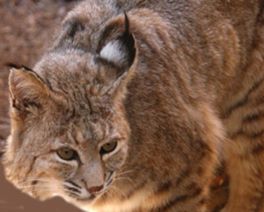
Bobcat – If you see a bobcat near your home, there is no need to panic. Bobcats may be attracted to your yard because it has abundant wildlife, domestic birds, small pets, water, and shade or other shelter. If you have small pets, they need to be protected from bobcats and other predators. Keep small pets indoors, in an enclosed area with a roof, or on a leash when outside (a 6-foot tall fence is not necessarily good protection as bobcats and coyotes are good jumpers and climbers). Domestic birds should be kept in an enclosed area with a sturdy roof, and do not spread seed that attracts other wildlife. Feeding bobcats, whether intentionally or inadvertently, can encourage them to become too comfortable around humans which may result in conflicts.
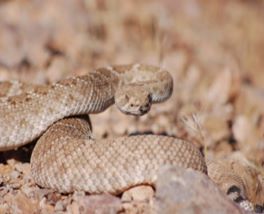
Mohave Rattlesnake – The rattlesnake is not an ideal animal to encounter on the mountain. They like to hide in crevices and under rocks. Always look where you are placing your hands and feet as these guys like to peak out of rocks. They most commonly come out in the hottest months and during darker times of the day and night. If you come across a rattler, stay calm until it slithers away. If you don’t wear headphones, you will be able to hear their signature rattling tail as a warning.
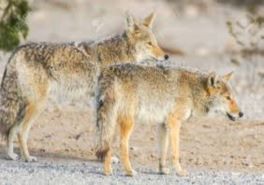
Coyotes – Coyotes are generally not a threat to humans. They are among the most commonly seen wild animals in Arizona. They eat rodents, rabbits, snakes and lizards, other small wild and domestic animals, mesquite beans, and any garbage they can find. Remember to always keep small pets in enclosed spaces. They weigh 20 to 30 pounds and measure 18 to 21 inches tall and 42-50 inches long. The distinct black patches at the base and tip of the tail help distinguish coyotes from dogs. They can hunt singly or in pairs. Family groups remain together during the summer and into early fall. You can often hear their yip-howls at night. If a coyote approaches you wave your arms and shout, throw rocks while maintaining eye contact will ususally make the coyote flee. Even if these actions don’t appear to be working, continue to exaggerate them. Continue eye contact and move toward other people, a building, or area of activity.

Kingsnakes – Kingsnakes vary widely in size and coloration. They can be 2 to 5 ft long. Some are colored in muted browns to black, while others are brightly marked in whites, reds, yellows, grays and lavenders that form rings, longitudinal stripes, speckles and saddle shaped bands. In most of the Sonoran Desert the kingsnake is a dark brown or black snake with narrower bands of yellow, white or cream going around the body, widening on the belly. Kingsnakes are primarily terrestrial, but they are known to be capable climbers and swimmers. They eat other snakes, lizards, rodents, birds and eggs. They tend to be active early morning and later afternoon when the weather is mild. Kingsnakes become nocturnal with the onset of extreme heat in summer.

Gopher Snake – The gopher snake is between 3 ft and 8 ft long. They range in color from cream-yellow to green-gray to tan, with large black, brown or reddish blotches on their back and smaller ones along their sides. Most have a dark line between their eyes and another from behind the eyes to the angle of the jaw. They hunt small rodents, young rabbits, lizards, birds and occasionally other snakes, usually by their sense of smell. Mainly diurnal become nocturnal during the hot summer months. They hibernate during the winter months. They are non-venomous and may become prey to hawks, foxes or coyotes. When in danger the snake coils up, vibrates its tail, and hisses a warning. They can even flatten their heads to look like a rattlesnake.

Ringtail Racoon – The ringtail racoon is the state mammal of Arizona. He is black to dark brown with pale underparts. He has a pointed muzzle with long whiskers, similar to that of a fox. Its body resembles that of a cat. The face resembles a mask as dark brown and black hair surround its eyes. They have long black and white ringed tails with 14 to 16 stripes. Its body measures 12 to 17 inches and its tail average 12 to 17 inches. It weights about 1.5 to 3.3 lbs. The are primarily nocturnal, with large eyes and upright ears that make it easier for them to navigate and forage in the dark. They eat birds, rats, mice, squirrels, rabbits, snakes, lizards, frogs, toads, insects, berries, prickly pear and fruits. They will even eat from birdseed feeders and hummingbird feeders. They are preyed upon by foxes, coyotes, hawks, and coatis. Miners and settlers once kept ringtails to keep their cabins free of vermin, hence the common name of “miner’s cat.”
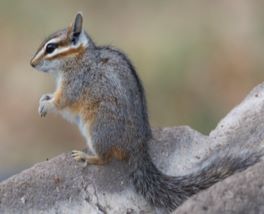
Cliff Chipmunk – The cliff chipmunk is a small, bushy-tailed squirrel that typically lives along cliff walls or boulder fields. They are very agile, and can often be seen scaling steep cliff walls. They create a “stash” of food that they frequent during the cold winter months. They vary from 8 to 10 inches and weigh an average of 2.5 oz. These small creatures live amazingly long life of up to 12 -1/2 years. They are brown on their underside and gray on the back, with white stripes on their face. Cliff chipmunks eat berries, seeds and acorns.
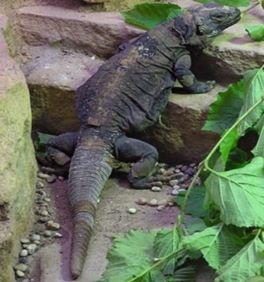
Chuckwalla – The chuckwalla lizard is found primarily in arid regions of the Southwest. He has a large, flat-bodied lizard with a large rounded belly and a wide-based, blunt-tipped tail. He reaches a total length of 20 in. and a weight of 2 lbs. Small scales cover its body with larger scales protecting the ear openings. The coloration varies between male and female, as well as between juveniles and adults. Males are black with a light speckle along their backs. Females are brownish with a scattering of red spots. Juveniles have broad bands across their bodies and tails that are lost in adulthood. They are harmless to humans as they will run from potential threats. When disturbed they enter a crevice and inflate their lungs to wedge their body tightly in place.

Cactus Mouse – Cactus mice are small rodents, with large eyes and ears, a pointed snout and a long monocolor tail. They average 6 to 8 in. in total length, and weigh between 0.6 and 1.4 oz. They can be identified by having naked soles on their hind feet and almost naked tails. Their ears are nearly hairless, large and membranous. They are found in dry deserts of the southwestern states. They feed on seeds, mesquite beans, insects and green vegetation. They are primarily nocturnal. Cactus mice can run around 13 mph!
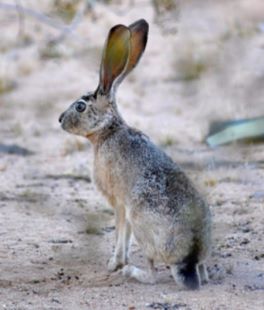
Black-tailed Jackrabbit – The black-tailed jackrabbit, also known as the American Desert Hare, is one of the largest North American hares reaching a length of 2 ft. and a weight of from 3 to 6 lbs. It has distinctive long ears and long powerful rear legs. Its fur is dark buff peppered with black, and its undersides and the insides of its legs are creamy white. The ears are black-tipped on the outer surfaces, and unpigmented inside. The ventral surface of the tail is gray to white and the black dorsal surface of the tail continues up the spine for a few inches to form a short black stripe. They live in mixed-shrub-grassland terrains. They can breed year-round in warm climates. They eat shrubs, small trees, grasses and flowers. They are prey for raptors and owls, coyotes, foxes and wild cats.